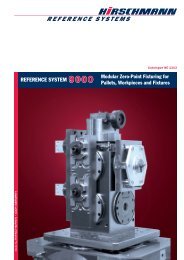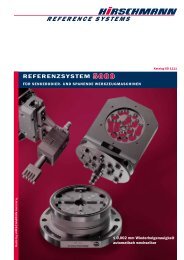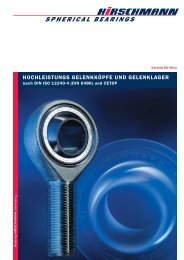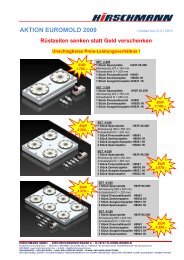heavy-duty rod ends and spherical bearings - Hirschmann GmbH
heavy-duty rod ends and spherical bearings - Hirschmann GmbH
heavy-duty rod ends and spherical bearings - Hirschmann GmbH
You also want an ePaper? Increase the reach of your titles
YUMPU automatically turns print PDFs into web optimized ePapers that Google loves.
Calculation examples<br />
Example 1:<br />
The conveying lever on a packaging machine is to be moved<br />
via a <strong>rod</strong> end. The designs calls for a size 12 <strong>rod</strong> end.<br />
Values dictated by design:<br />
Alternating constant dynamic radial load F r<br />
1200 N<br />
Swing angle 30°<br />
Swing frequency f 120 rpm<br />
Operating temperature 50° C<br />
Since the load is alternating <strong>and</strong> constant, a lubricated<br />
design is recommended according to the section “Selection”<br />
(page 5), e.g. SMC 12.<br />
Catalogue values:<br />
Dynamic bearing capacity C 13400 N<br />
Static bearing capacity Co 17000 N<br />
Inner ring ∅ K 22.225 mm<br />
Requirements on <strong>rod</strong> end SMC 12:<br />
1. Radial load F r must be smaller than the permissible<br />
load P perm. to avoid permanent deformation.<br />
2. The service life G h, req. should be at least 6000 operating<br />
hours.<br />
Calculation:<br />
Dynamically equivalent bearing load P:<br />
Fa<br />
P = Fr + Y · F __<br />
a |<br />
P = F r = 1200 N<br />
F r<br />
= 000 ____<br />
1200 = 0 | Y = 0<br />
Permissible <strong>rod</strong> end load Pperm. :<br />
Pperm. = Co · b2 · b4 | b2 = 1 (acc. to Fig. 12)<br />
b4 = 0,35 (acc. to Fig. 11)<br />
Pperm. = 17000 · 1 · 0,35 = 5950 N<br />
P = 1200 N < Pperm. = 5950 N (1st requirement met)<br />
Determination of service life G h :<br />
G =<br />
h b1 · b2 · b3 · 107 · C__<br />
K · · f P<br />
b 1 = 2,5 (Fig. 12)<br />
b 2 = 1 (Fig. 12)<br />
b 3 = 2,1 (Fig. 13) | C__ P<br />
[h]<br />
= 13400 _____ = 11,1<br />
1200<br />
G h = 7200 h > G h, req. = 7000 h (2nd requirement met)<br />
Checking of lining for overheating:<br />
p = k c · P__<br />
C [N/mm2]<br />
p = k c = 50 N/mm 2 (acc. to Fig. 4)<br />
p = P__<br />
C<br />
= 1200 _____<br />
13400<br />
= 111 ____ = 0,089<br />
11,1<br />
p = 50 · 0,089 N/mm 2 = 4,45 N/mm 2<br />
v = 1,745 · 10 -5 · K · · f = 1,745 · 10 -5 · 22,225 · 30 · 120 m/min<br />
v = 1,4 m/min < v perm. = 15 m/min (acc. to Fig. 14)<br />
p · v = 4,45 · 1,4 = 6,23 < (p · v) perm. = 30 (Fig. 14)<br />
No overheat<br />
Lubrication interval:<br />
t = Gh ___<br />
130<br />
= 7200 _____ = 55 h<br />
130<br />
Example 2:<br />
A lever of a filling machine is moved via a double-action<br />
pneumatic cylinder. A maintenance-free <strong>rod</strong> end with<br />
mounting dimensions to CETOP is required.<br />
Values dictated by design:<br />
Variable, pulsating, radial, dynamic load<br />
F1 = 2000 N, F2 = 6000 N, F3 = 3000 N. Fmax = 8000 N<br />
q1 = 20%, q2 = 15%, q3 = 65%<br />
Constant axial load Fa 1000 N<br />
Swing angle 25°<br />
Swing frequency f 60 rpm<br />
Operating temperature max. 80° C<br />
Requirements on <strong>rod</strong> end:<br />
1. The dynamically equivalent bearing load P <strong>and</strong> the statically<br />
equivalent bearing load Po must be lower than the<br />
permissible load Pperm. 2. The service life Gh, req. must be at least 11000 operating<br />
hours.<br />
Calculation:<br />
Mean dynamic bearing load F m:<br />
F m =<br />
F m =<br />
<br />
F2 1 · q1 + F2 2 · q2 + F2 3 · q ____________________________________________ 3<br />
Q<br />
<br />
20002 · 20 + 60002 · 15 + 30002 _______________________________________________________________ · 65<br />
= 3471 N<br />
100<br />
Dynamically equivalent bearing load P:<br />
Fa<br />
P = Fm + Y · F __<br />
a || F<br />
m<br />
= 1000 ____ = 0,28<br />
3471<br />
Y = 1,44 (interpolated acc. to Fig. 7)<br />
P = 3471 + 1,44 · 1000 = 4911 N<br />
Determination of relative service life ¯G h:<br />
G _<br />
h = Gh = · f ______<br />
b ·b |<br />
1 2<br />
= 25 | b1 = 1 (Fig. 12)<br />
f = 60 b2 = 1 (Fig. 12)<br />
G _<br />
h = 11000 · 25 __ ·60 ____<br />
1 · 1 = 16,5 · 106 h<br />
On the basis of the chart (Fig. 16) the <strong>rod</strong> end size<br />
calculated is 16<br />
SFCP 16 CETOP is selected (page 17).<br />
Dynamic bearing capacity C 60000 N<br />
Static bearing capacity Co 28500 N<br />
Inner ring Ø K 28,575 mm<br />
Limit value fc = C__ = 60 __ 000<br />
P ____ = 12,2 (correct acc. to Fig. 8)<br />
4911<br />
Permissible road end load Pperm. :<br />
Pperm. = Co · b2 · b4 | b2 = 1 (Fig. 12) | b4 = 0,5 (Fig. 11)<br />
Pperm. = 28 500 · 1 · 0,5 = 14 250 N<br />
<br />
Po = Fmax = 8000 N < Pperm. 1st requirement met<br />
P = 4911 N < Pperm. Determination of service line G h:<br />
G =<br />
h b1 · b2 · b3 ·107 ·<br />
C__<br />
P | b3 = 4,2, für C__ K · · f<br />
P<br />
= 12,2 (Fig. 13)<br />
Gh = 1·1· 4<br />
28,575 · 25 · 60 · 107 · 12,2 = 11900 h<br />
Gh, req. = 11000 h < Gh = 11900 h (2nd requirement met)<br />
11






